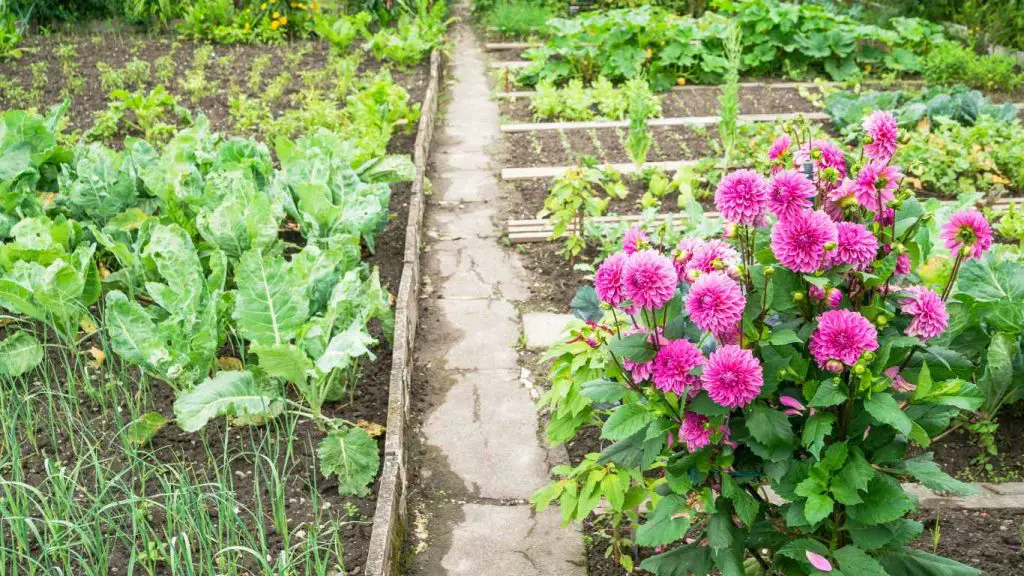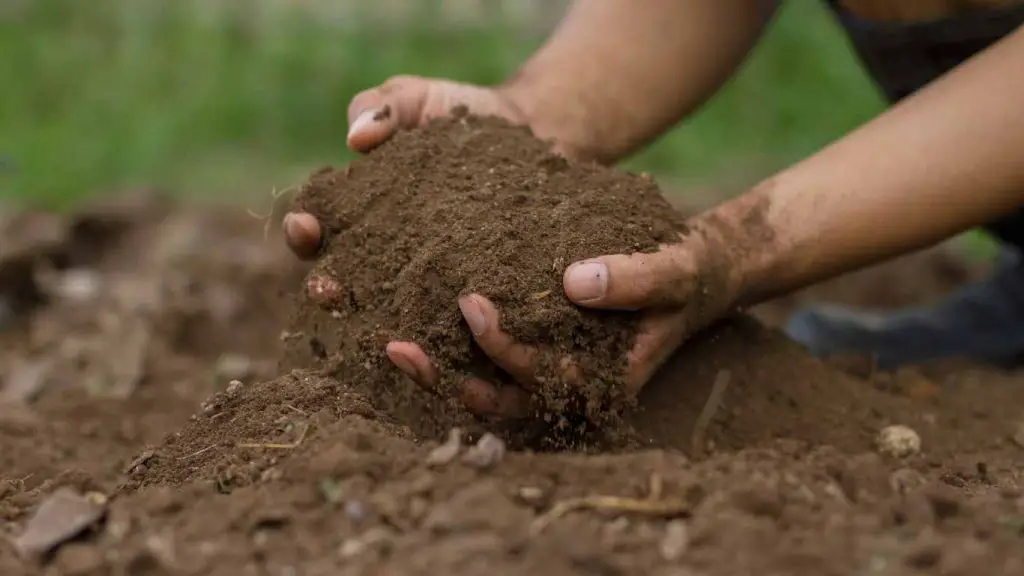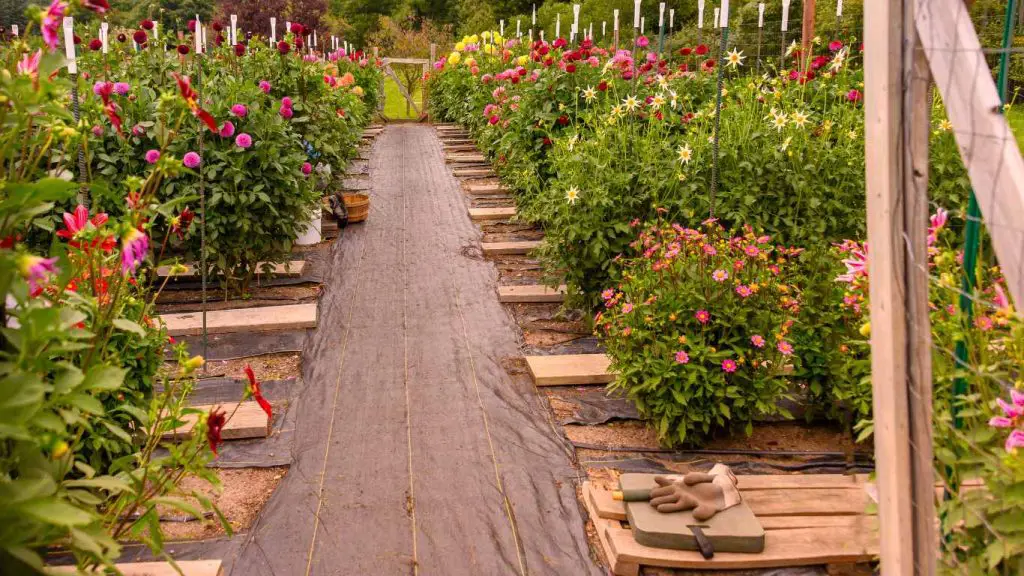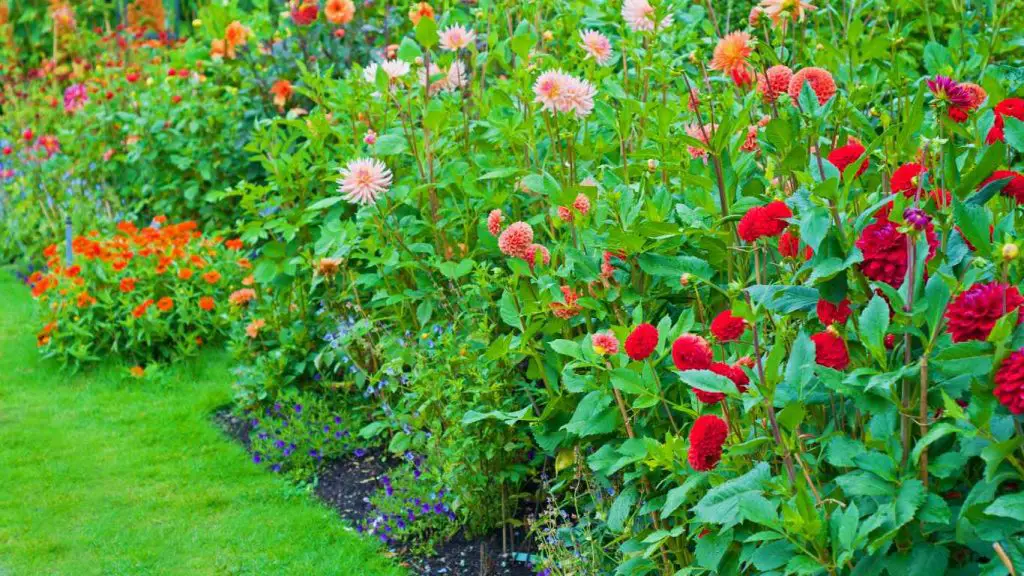A great way to grow dahlias is to put them in raised beds. You might want to build a raised bed for your dahlia garden if the soil doesn’t drain or hold water well. If you live in a place that floods often or gets a lot of rain, you might want to grow your dahlias in a raised bed. You can buy one online or build one yourself.

Getting a garden bed ready for dahlias takes a few steps to make sure the soil is right for their healthy growth and lots of blooms. Here are some steps to help you get your garden bed ready for dahlias
1: Best Location For A Dahlia Bed
Dahlias do best in full sun. They need a lot of sunlight to grow and bloom lots of flowers. Plant them somewhere in your garden that gets at least 6 to 8 hours of direct sunlight every day. Dahlia plants may get tall, flower less, or not do well if they don’t get enough sunlight.
Why full sun is important:
Flowering: Dahlias are known for having beautiful, colorful flowers, and they need a lot of sunlight to make flowers. Flowers may not bloom as much or as brightly if they don’t get enough sunlight.
Plant vigor: Full sun helps plants grow well and be strong overall. If Dahlia plants are kept in a shady place, they might get weak, spindly, or prone to diseases.
Disease prevention: Fungal diseases like powdery mildew and botrytis are less likely to affect dahlia plants when they are in humid conditions because sunlight dries out the leaves.
Flower size and color intensity: Sunlight changes how big and bright the colors of dahlia flowers are. When plants are grown in full sun, their flowers are usually bigger and more colorful than when they are grown in partial shade.
2. Amend The Soil For Dahlias

Dahlias are produced from tubers, which retain nutrients during the dormant season and shield the plant beneath the earth so that it can reappear the following year. This tuber is highly susceptible to rotting, particularly in the early growth stages when roots have not yet formed.
Due to their sensitivity, most varieties of dahlias prefer light, well-draining soil. It ought to be devoid of any clay particles that could retain moisture and impede the soil’s ability to absorb oxygen.
Apart from this prerequisite, they don’t have many requirements and can thrive in nearly any type of soil.
Dahlias grow best in rich, fertile soil, but with the right care and added nutrients, they can flourish almost anywhere. For instance, to keep dahlias happy, you may need to water or fertilize them more frequently if your soil leans too much toward the sandy side.
Your dahlias will continue to grow nicely as long as the soil isn’t overly wet or saturated.
If you have no choice but to work with soils that are higher in clay, you can amend the soil to promote better drainage. Compost mixed with river sand will create the perfect balance. Sand can be added indefinitely until the soil can drain water without restriction.
If your soil is excessively sandy, adding peat moss and compost will increase its ability to hold moisture. However, exercise caution when adding too much, as these materials retain a lot of moisture and can cause the roots to rot.
3. Create The Raised Bed For Dahlias

Get rid of any grass or weeds that are growing in the spot where you want to build your raised bed. Utilize a hoe, weed eater, or garden spade to remove vegetation that is near the ground.
To prepare the ground for your raised bed, level it as much as you can. To get rid of any soil depressions or bumps, use a shovel or rake.
Design The Layout:
Start by drawing a rough plan of how your garden will be set up. Think about the space you have, how much sunlight it gets, and any landscape features that are already there. Pick out the size and shape of your raised beds.
Beds often come in rectangular, square, or round shapes. A good width is about 3 to 4 feet, which lets you reach the middle of the bed from both sides without having to step in the dirt.
Lining The Beds:
Lining a no-dig raised bed with bricks, cinder blocks, and wood can make a strong and attractive border that helps keep the soil in place and defines the edges of the bed.
Along the edge of the raised bed, put the first row of bricks or cinder blocks. Place them so that they are level from front to back and from side to side. You don’t have to use anything; just follow these steps to make your bed.
Lay Cardboard Or Newspaper:
Use a thick piece of cardboard or several layers of newspaper to cover the space that you just cleaned up. This will kill any plants that are already there and stop weeds from growing through the raised bed. You don’t need to add cardboard or newspaper if there are no weeds on the ground under your beds.
Fill The Beds:
Put garden soil in the raised bed, leaving about an inch of space at the top for the compost or manure. Add a layer of compost or manure that has been broken down well on top of the garden soil. A depth of about 4 to 6 inches is good.
Dahlias like soil that is slightly acidic to neutral (pH 6.5–7.5). A soil testing kit can be bought at garden centers or from your local agricultural extension service to find out what the pH level of your soil is.
Related Articles About Building A Bed:
- Best Raised Bed Gardening Soil Mix Recipe
- Every Thing About Watering Your Plants In A Raised Bed Garden
- How To Build A Raised Bed With Cinder Blocks?
4. Plant Dahlia Tubers In Garden Bed
Here are the step-by-step instructions to plant dahlias tubers in your new or improved garden bed:
Digging a Hole: Make a hole in the ground that is 4 to 6 inches (10 to 15 cm) deep. Dahlia plants store food in their tubers, which are located below ground. This depth gives them enough room.
Positioning the Tuber: Position the dahlia tuber horizontally in the hole, so that the growing eye is facing up. The tuber’s growing eye is a tiny bud or indentation where the new growth will eventually emerge.
Once the tuber has been inserted, backfill the hole with soil. To give the tuber stability and support, make sure the soil is tightly packed around it.
Spacing Between Plants: It’s important to leave enough space between dahlia plants because they can get pretty big. There should be at least 12 inches (30 cm) of space between each tuber you plant. The plants can grow without being too close together, which can cause them to compete for resources and not grow well.
5. Taking Care Of Your Dahlias

Watering Requirments: Dahlias need to be watered regularly all summer, so set them up with soaker hoses or drip irrigation when they are still young. You shouldn’t water dahlias until you see the first green shoots coming up through the ground.
If you water them too much before you see the shoots, the tubers will rot. When plants are 8 to 12 in (20 to 30 cm) tall, cut out 3 to 4 in (7 to 10 cm) of the growing center to give them a hard pinch. This will encourage low basal branching, which will make more flowers and longer stems overall.
Save From Pests: Young plants are harmed by slugs and snails, and the flowers are ruined by earwigs. Bait should be applied at planting time and on occasion during the season. Sluggo Plus is an organic solution that effectively combats all three pests and is safe for kids and pets.
Support Your Plants: Tall plants will need to be staked by midsummer to prevent them from toppling over. If you’re a home gardener with a small number of plants, you can tie stems to your tubers as they grow by planting tall, sturdy posts next to them.
For flower farmers, I suggest the corral method, which is stringing double layers of bailing twine from post to post and erecting metal T-posts every 10 feet (2.4 meters) along the outside edges of the beds.

